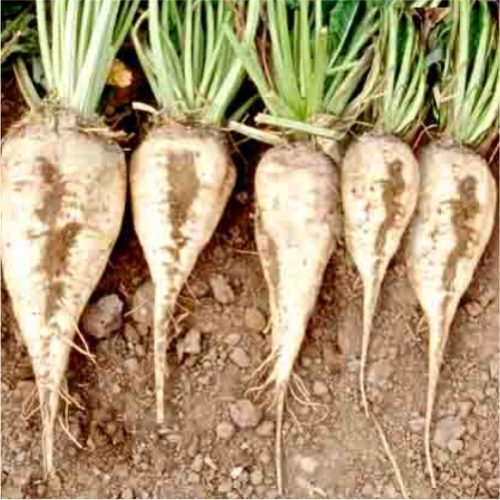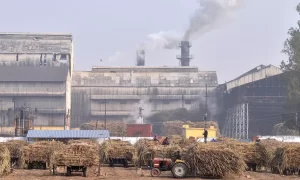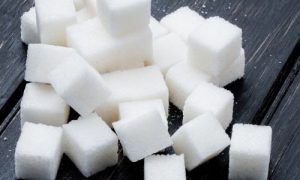Wyoming Grower Expects To Bring In 525,000 Tons Of Super-Sweet Sugar Beets

At Wyoming Sugar Co., the harvest is in full swing as trucks haul sugar beets to the factory from farms across the region. With nearly 13,500 acres yielding high sugar content, the sugar beet campaign is vital to the local economy. This grower-owned factory has been refining sugar for over 100 years, sustaining generations of farmers.
WORLAND — At the Wyoming Sugar Co., the steady roar of engines and hum of conveyor belts filled the factory yard as men methodically went about their work. The mountain of sugar beets grew under the watchful eye of the workers, and the ventilators blew air beneath the massive pile to keep the beets cool until they could be moved into the factory.
From the fields surrounding Worland, the trucks rolled in of every size, make and model imaginable. They were coming from small family farms to large corporations with both hired hands and owners driving the rigs. The one thing these massive semis had in common was that they were all hauling full loads of sugar beets, the lifeblood of Worland.
The sugar beet campaign is fully underway and things are looking good for Wyoming’s sugar industry.
“This year we have nearly 13,500 acres of sugar beets coming in,” sugar beet farmer Jim Miller said. “They are figuring 35 to 39 tons per acre with a high sugar content.”
Wyoming Sugar Co.
Founded in 1916, the sugar beet factory has been refining sugar in Worland for over 100 years. The process begins with the harvest.
“A defoliator goes along the field, takes the tops off of the beets, and that just leaves the root,” Miller said, describing the technique modern farmers now use for the harvest rather than the hard labor of the past. “The beet digger comes in and has a set of polar wheels that are set on the beet, and it pops them up and sets them back onto a chain bed. The sugar beets go on the grab roll, where it spins them to get the dirt off. Next, they go up an elevator into a tank, and it goes over, through the elevator onto the trucks.”
Miller points to the factory yard in Worland where a steady stream of trucks are unloading their sugar beets before the heat of the day forces the deliveries to end. After being weighed, the sugar beets are unloaded on a conveyor built which sorts out the remaining dirt on the beets. This dirt is returned to the truck and usually taken back to the field it came from.
The sugar beets are put in giant mountains until they can be placed once more on a conveyor belt, this one leading directly to the factory where the sugar is processed. The remaining pulp from the sugar beets are then used by farmers, such as the Millers, for feed for cattle and sheep to help fatten them up during the long winter months.
A Family Business
Miller is a third-generation sugar beet farmer, and his son is now working alongside him on the family ranch. He started working right out of high school and said that you must love the work to be able to put up with the ups and downs of it.
“When I got out of high school in 1976, Dad had rented 400 more acres the year before, so my brother and I just started farming with him, because he needed the help,” Miller said. “We were the hired men, and I never had a reason to go to college. We all started farming as we got out of high school.”
“I don’t know how my family ended up Wyoming,” Miller said, a bit ruefully at the lost history. “They were German immigrants in Russia, and they got chased out by the Bolsheviks. My Dad was then born in Basin. In 1953, Grandpa and Dad bought the place in Worland, and we have been here ever since.”
Miller is one of five brothers working on the family ranch alongside the next generation of sugar beet farmers, his son and nephews. Each brother has their area of expertise as they expanded into other industries besides sugar beets.
“Andrew takes care of all the sheep; I take care of the sugar beets and Pete takes care of the corn. Hugh is the handyman and Daniel’s the mechanic.”
The family is obligated to deliver 350 acres of beets to the sugar factory and are considered a mid-sized grower. As they enter into the sugar season, they will recruit anyone willing to drive a truck. Even their in-laws work for them on the weekends.
The Beet Goes On
“There’s a lot of good things,” Miller said. “but you get some tragedies, too. We had a bit of a hailstorm on the 10th of September on one of our fields. It shredded our beets a little bit, but the rest of them are looking good.”
The sugar content is key to their profits, and Miller is very aware of anything that can adversely affect this.
“Hail can defoliate the tops,” he said, “and when they start growing new tops, it takes away the sugar content, because instead of taking the nutrients from the leaves, putting it into the beet, the beet starts growing new leaves, and then the sugar content goes down.”
Strange weather patterns can also help the sugar beet farmer and Miller says this year’s heat wave has been a boon for his crop.
“Our sugar content is really good this year because the beets are dry,” he said. “Normally we get a winter storm or some kind of rain, and that diffuses the sugar in the beet. That is because the beet absorbs the moisture and that causes the sugar content to go down a little bit. But this year it’s been exceptionally dry.”
Saving A Sugar Legacy
Sugar beets have been an important crop in the Big Horn Basin for nearly 120 years and over 70 years for the Millers. The first sugar beet crop was planted in 1905 by J.W. Pulliam. He had planted 600 acres of sugar beets and grain as a pilot project and the beets were soon being brought to the Worland depot by wagon and horse to be shipped by rail to Billings, Montana, for processing.
In 1916, the success of the sugar beets in the region caught the attention of investors. A local factory and housing for the workers, called ‘Sugar Row,’ was built by the Wyoming Sugar Co. of Ogden, Utah. The $1 million factory was completed in time to process the 1917 sugar beet crops.
Things were going well for the region but, by 2002, Imperial Sugar threatened to close the local sugar factory. The community of Worland and farmers rallied around their sugar industry. Local investors comprised of growers, local business, employees and citizens purchased the factory, saving it from closure.
Today, the Wyoming Sugar Co. is a grower-owned factory and its success is due to this consortium of growers and concerned citizens who put the money together and bought it, including the Miller family.
“We all share in the profit,” Miller said. “We also share in the loss. It’s a shared situation. We get paid for the sugar content and the tonnage, and then it is all based on what they sell the sugar for through the Sugar Marketing Association.”
Banking On Sugar
“Hopefully the sugar factory is here for years to come,” Miller said as he maneuvered his truck out of the sugar factory yard, ready to head home for the day. “It is very vital to our area. It employs quite a few people during the sugar beet campaign and that’s why the growers in the community came together to buy it years ago, to keep it here.”
Sugar from Worland and the Big Horn Basin is sold on the open market and distributed to consumers across the United States. Since the sugar content from sugar beets matches that of sugar cane, these two types are often blended and marketed as pure cane sugar on grocery store shelves so that Miller isn’t even sure where his sugar ends up after being distributed.
Before he heads back to the family farm, Miller looked back over at the factory and smiled. This massive factory is part of his family’s legacy. He wouldn’t trade it for any other career or lifestyle.
This sugar he has helped to produce is a Wyoming product that he hopes will continue to sustain the next generation of sugar beet farmers.














